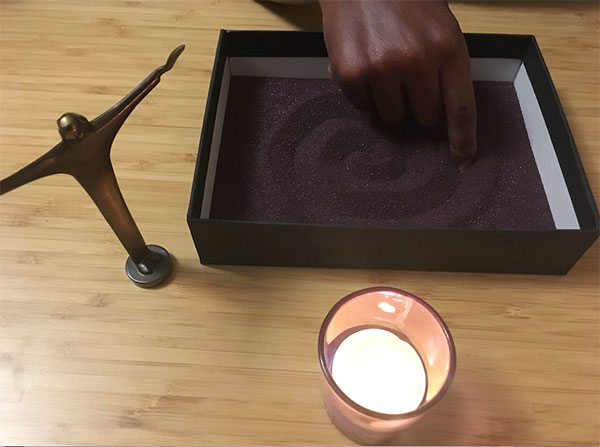Sunday mornings find me on zoom with a gathering of kids ages 3 – 10. We call this time Songs & Stories. It is a highlight in my week. They come in their pajamas, often eating breakfast, and usually with some “stuffies” they want to introduce to the group. They are full of energy and good cheer. They mute and unmute themselves better than those in any other zoom meeting I attend. The screen fairly vibrates with their good morning energy.
Christians are in the season of Lent right now, the church’s six week liturgical season preceding Easter. It’s a season of preparation and my Sunday morning kids would eagerly tell you that the color of this church season is purple. Everything at church is purple — we see it on the screen — the pastors’ robes, the paraments on the altar, etc. And we have some purple in our homes — on our kitchen tables, socks on our feet, ribbons in our hair — to remind ourselves we are in this purple time, this Lenten time.
The kids all received a bag of purple things before Ash Wednesday — a purple candle, purple playdough, purple papers, purple yarn, and the parents’ favorite (I’m sure of it!) a 5×8 box filled with purple sand. We are using all of these purple tools to explore new ways of praying during Lent.
The purple sandbox is for centering prayer. I confess, I was not sure this would work — especially with the Zoom factor, which is about as uncentering an experience as can be found. But you don’t know until you try, and I’m awfully glad we’ve tried. It’s been fantastic.
We talk about quieting our bodies and brains, opening our hearts and minds and our very selves to God’s peace and love. I ask them to draw very slow spirals with one finger in the sand and we breathe in through our nose…2…3…and out through our mouths…2…3….

All of the wonderful frenetic energy on the screen calms a few spirals in. I see little noses scrunching up to breath in, lips pushing out to breath out. I see the messy morning parts in their hair because they are busy looking down, intent on the prayerful spirals their finger is drawing.
 Once most of the zoom squares are still, I read them Mary Oliver poetry. I know, I know — Mary Oliver is an “adult” poet (you know what I mean!) But she uses words in such a divine way. I read to them about the wild things: whistling swans and singing wrens, the flowers and trees and geese. I read them Mary’s grace-filled, enthusiastic, welcoming theology of prayer because it’s the best language I know around this sometimes tricky topic.
Once most of the zoom squares are still, I read them Mary Oliver poetry. I know, I know — Mary Oliver is an “adult” poet (you know what I mean!) But she uses words in such a divine way. I read to them about the wild things: whistling swans and singing wrens, the flowers and trees and geese. I read them Mary’s grace-filled, enthusiastic, welcoming theology of prayer because it’s the best language I know around this sometimes tricky topic.
Then a wren in the privet began to sing.
He was positively drenched in enthusiasm,
I don’t know why. And yet, why not.
I wouldn’t persuade you from whatever you believe
or whatever you don’t. That’s your business.
But I thought, of the wren’s singing, what could this be
if it isn’t a prayer?
(You can listen to Mary read this herself here. It’s pretty great.)
I want these kids to know their prayers need not be collections of perfect blue irises, but will sometimes be a few small stones, or even weeds in a vacant lot, as they go through life. Adults often have so many shoulds around prayer — I’m trying to inoculate these kids.
“Do you bow your head when you pray or do you look up into the blue space?” I ask them while they spiral to their center.
“Take your choice, prayers fly from all directions.
And don’t worry about what language you use,” I tell them.
God no doubt understands them all.
(from “Whistling Swans”)
Mary Oliver is willing to admit she doesn’t know exactly what prayer is — only that it is good and can often best be accessed outdoors in nature. She calls us to pay attention, to not be so very sure of every single thing, but only the really important things like steadfast love and grace and kindness and joy.
I watch these small faces, these tender souls with their great big hearts, and I think they are as ready and deserving of Mary Oliver poetry as any of us. And so I read it to them as they draw their centering spirals in purple sand.
To those adults who ask the earnest question, “But do they understand her poetry?” I gently ask, “Do you?”
These wild and precious lives on my zoom screen give me such hope.

Melanie, I felt calmer just reading this. Yay for you, reading Mary Oliver to children! Her honest, hopeful, lyrical voice is perfect for them. What a great service you are doing for these young souls.
Thank you, Joyce! These young souls are doing a great service for ME, as well. It’s a lovely time we have together.
Poetry should never be considered “over the heads” of children, especially Mary Oliver’s. If meaning slips past (reading poetry on their own, without guidance), the language stays with them.
Indeed! Such beautiful language. I think it’s that her poems are about animals and nature – that’s what makes them accessible for kids and adults.
Your post made my heart sing! I love Mary Oliver’s poetry, and imagining those small faces listening and pondering her words is perfect. Thank you for sharing.
Thanks you! I’m glad you enjoyed!
Bless you! As a “practicer” of prayer and an Episcopal priest, I am grateful for your courage and creativity.
Thanks, Anne. I am a Lutheran Pastor, and very much a practicer of all the holy things.